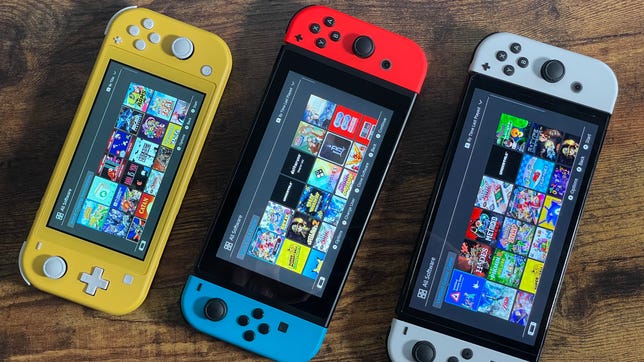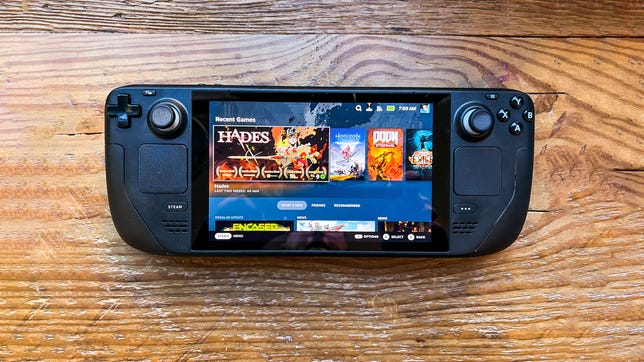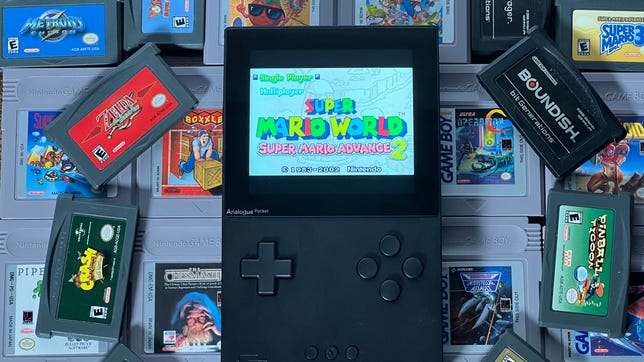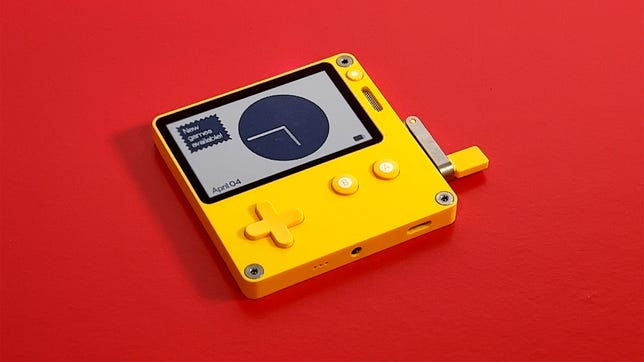Technologies
Best Handheld Game Console in 2023
Take your gaming on the go with the best handheld game consoles, from the Nintendo Switch to Valve’s Steam Deck.

The last few years have seen a revival of handheld game consoles thanks to the convenience of on-the-go gaming and streaming technology, no doubt in part due to the success of the Nintendo Switch in 2017. The world of handheld gaming has gained popularity like never before, and last year was no exception. With the release of new consoles such as the Steam Deck and Panic Playdate, as well as the Razer Edge and Logitech G Cloud, more users are looking to handheld consoles for all of their gaming needs. If you’re looking to get back to the days of playing games anywhere you want, we’ve rounded up some of the best handheld game consoles that 2023 has to offer below.
Phones and tablets already do a fine job of playing tons of great portable games, and have been leading the mobile gaming world for years, offering features like game controller cases and game streaming from consoles, PCs and the cloud. Dedicated devices can provide unique features, exclusive games or extra power to do things your phone can’t. It almost feels like a return to the mid-2010s era of the Nintendo 3DS and PlayStation Vita.
The Nintendo Switch has been the best and most affordable portable game system for years, and continues to be CNET’s clear top pick: At $300 (or $350 for our favorite model), it can play a huge variety of Nintendo games, indie games, it can dock with a TV and can even play some fitness games. But Valve’s Steam Deck offers a unique proposition for those with deeper pockets: It’s large, and it can double as a full gaming PC.
For those who miss retro game handhelds like the Game Boy, you might consider putting yourself on the waiting list to order the Analogue Pocket or Panic Playdate, too, but both of those systems are more niche, and more indie/retro targeted, than the Switch and Steam Deck.
We’ll explain below.
Scott Stein/CNET
The Nintendo Switch is over five years old now, but Nintendo has indicated that no true successor is coming right now. A Pro model has been rumored for a while, but in the meantime the existing Switch remains extremely capable, full of great games (including lots of indie offerings), and pretty affordable considering its handheld/TV-connected dual function.
The OLED-screened Switch, which released in October 2021, is the best Switch and our recommended pick. The more vivid and larger display looks fantastic, its rear kickstand works better for tabletop gaming, and both of these upgrades are worth the extra $50. The original Switch (or the V2 version), at $300, works similarly and is also still fine, and occasionally comes in special editions and holiday game bundles. The smaller, handheld-only Switch Lite is a great value pick at $200 for anyone who just wants a basic portable game system, but it lacks any ability to connect to a TV, and its controllers don’t detach. This makes it less versatile for families, and means you can’t replace the controllers if they break.
Dan Ackerman/CNET
Valve’s big and powerful Steam Deck is a marvel. It can play a wide variety of PC games surprisingly well, and is the dream portable for any hardcore Steam fan, or anyone who has a big library of PC games. The Steam Deck can get expensive for the larger storage tiers, but for what it’s capable of, it’s not a bad deal. The ability to play PC games or stream cloud-based games, and to connect to a monitor, keyboard or other accessories, puts the Steam Deck in a class of its own.
Scott Stein/CNET
The Pocket looks like a totally remade Game Boy, and it is, in a sense. Analogue’s gorgeous handheld can play original Game Boy, Game Boy Color and Game Boy Advance cartridges perfectly, and can even play Sega Game Gear games using an adapter (Atari Lynx, Neo Geo Pocket and Turbografx-16 adapters are supposed to be coming soon). It has a high-res color screen and USB-C charging, and there’s a separately sold dock for TV play. One of the most exciting updates to the Pocket is its support for FPGA cores that can replicate classic game hardware, and play ROMs. There’s no game store for buying games: Pocket is a system to play classic cartridges or other games in amazing quality, if you want to tinker around with FPGA. There’s also a growing library of Pocket-compatible software in indie gaming channels like itch.io that can be sideloaded to a microSD card, too.
The tiny, yellow, black-and-white-screened Panic Playdate looks like a weird Game Boy with a mechanical crank sprouting from its side. But this system, made by the indie game company that developed Untitled Goose Game, plays its own tiny season of 24 indie-developed games, which come included with the purchase and appear over time like weekly presents. The Playdate has Wi-Fi and can download games or sideload other indie-developed titles from sites like itch.io, but you’ll have to learn to love the experiences you discover. We’ve loved playing on it so far, but alas, the Playdate doesn’t have any backlighting — you’ll have to find a lamp instead. The Playdate is on backorder until early 2023.
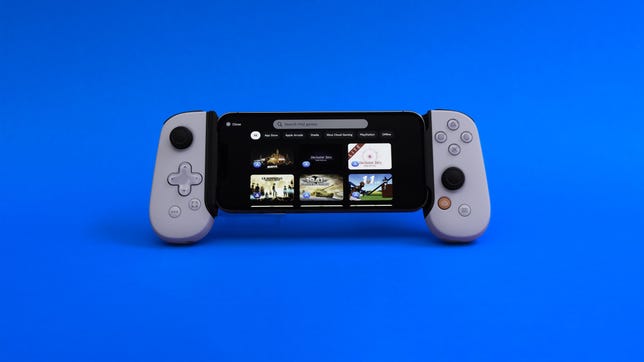

Lori Grunin/CNET
Should I just use my phone or iPad instead?
Tablets and phones are extremely valid game consoles: The iPad has tons of games on the App Store, and hundreds more on Apple’s subscription-based Apple Arcade. The iPad can pair with Bluetooth game controllers, too. iPhones and Android phones have tons of games as well, obviously, and a number of great game controller cases are available, including the Backbone and the Razer Kishi.
Phones and tablets also offer other advantages, including an ability to cloud-stream games on a growing number of services including Microsoft Game Pass Ultimate and PlayStation Plus.
The handhelds listed above have other advantages: unique game libraries, a chance to connect to a TV and play with others, and the capability to play higher-end PC games or classic game cartridges.
Should I wait for something else?
The Nintendo Switch Pro, a long-rumored upgrade to the Switch, could eventually offer 4K gaming and perhaps upgraded controllers, although the existence of such a device is entirely speculative. Odds are that Nintendo will instead just keep slightly improving the Switch via new models every couple of years, similar to how it kept upgrading its Nintendo DS and 3DS line over time.
The Steam Deck just arrived earlier this year, but it’s unclear when and if Valve will ever choose to upgrade it with better processors or newer features. And right now, Microsoft and Sony have stayed out of the handheld gaming picture.
Razer’s Android-based gaming tablet, the Razer Edge, shows where a wave of new gaming tablets could emerge to become the Steam Decks of the mobile world. Right now we don’t have any opinions on whether you should wait for it, because we haven’t played it yet.
Logitech’s streaming-only G Cloud handheld shows where more console/PC accessories could pop up as home handhelds to stream games away from a TV, but right now you’re probably better off using your phone or tablet and a game controller to do pretty much the same thing.
What’s best for kids?
My kids alternate between iPad gaming and the Nintendo Switch. The Switch is without a doubt the best kid console, with the most family-friendly game library and best parental control settings. Still, be prepared to get annoyed at buying multiple copies of games and trudging through the process of creating multiple Switch family accounts.
Game console reviews
Technologies
Two Cryptocurrencies in One Messenger: Verum Messenger Adds Bitcoin Mining
Two Cryptocurrencies in One Messenger: Verum Messenger Adds Bitcoin Mining

The private Verum Messenger, primarily chosen by users for secure communication, now offers a new way to use the app. To the existing ability to mine its native Verum Coin cryptocurrency, Bitcoin mining has been added. Both functions operate in parallel within a dedicated tab of the messenger.
The Convenience of Built-in Mining
The main advantage of this solution is its simplicity. Users do not need to:
- Install additional software
- Study complex setup instructions
- Undergo additional verification checks
- Mining is activated in a separate application tab, and the mined funds can be withdrawn to an external crypto wallet at any time.
The Evolution of a Private Messenger
The addition of Bitcoin mining is a logical step in the evolution of the Verum Messenger ecosystem. The app is gradually transforming from a simple communication tool into a multifunctional platform.
In addition to mining, the following features are already available:
- A built-in VPN for secure connections
- eSIM with internet access in 150+ countries
- Full encryption of all data
- The ability to completely delete chat history and setting
What This Changes
Verum Messenger now offers users not just a protected space for communication, but also the ability to earn cryptocurrency simultaneously. This is especially valuable for those who want to get started with mining without delving into technical complexities.
This approach aligns with the project’s overarching philosophy — to create secure and user-friendly digital solutions that offer more opportunities while maintaining confidentiality.
Technologies
Today’s NYT Connections: Sports Edition Hints and Answers for Nov. 30, #433
Here are hints and the answers for the NYT Connections: Sports Edition puzzle for Nov. 30, No. 433.
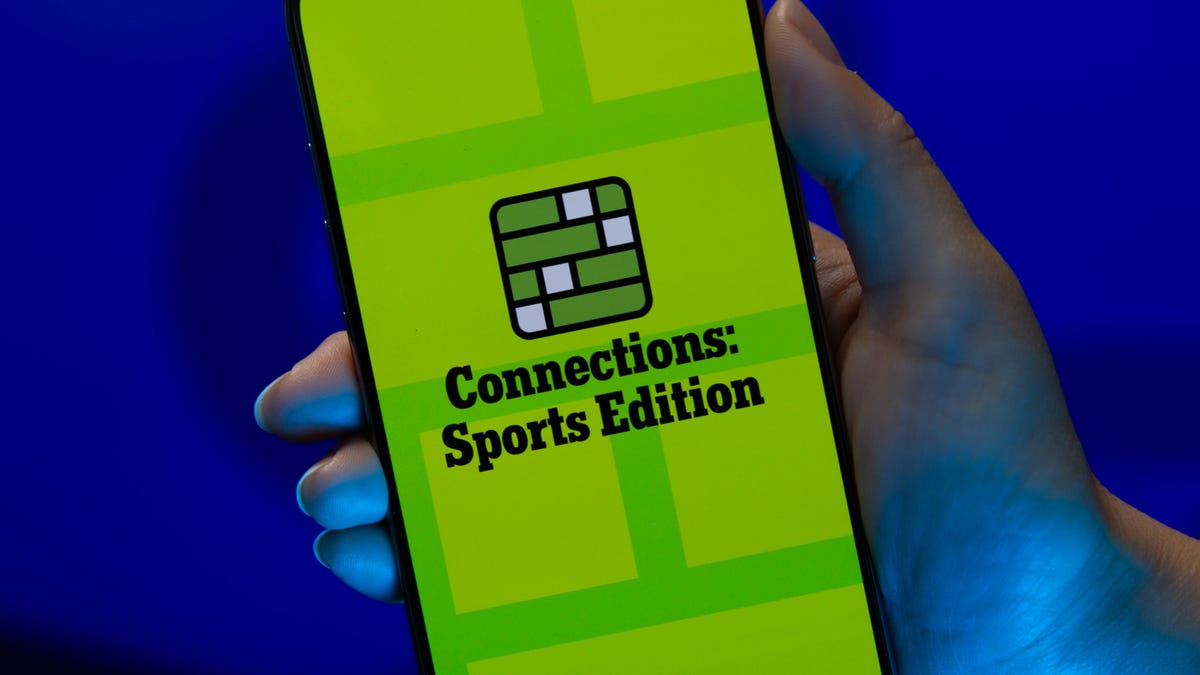
Looking for the most recent regular Connections answers? Click here for today’s Connections hints, as well as our daily answers and hints for The New York Times Mini Crossword, Wordle and Strands puzzles.
Today’s Connections: Sports Edition is a tough one. If you’re struggling with today’s puzzle but still want to solve it, read on for hints and the answers.
Connections: Sports Edition is published by The Athletic, the subscription-based sports journalism site owned by The Times. It doesn’t appear in the NYT Games app, but it does in The Athletic’s own app. Or you can play it for free online.
Read more: NYT Connections: Sports Edition Puzzle Comes Out of Beta
Hints for today’s Connections: Sports Edition groups
Here are four hints for the groupings in today’s Connections: Sports Edition puzzle, ranked from the easiest yellow group to the tough (and sometimes bizarre) purple group.
Yellow group hint: Gridiron gains.
Green group hint: Get a kick out of it.
Blue group hint: Baseball legend.
Purple group hint: Rocky Mountain team.
Answers for today’s Connections: Sports Edition groups
Yellow group: Football scoring plays, abbreviated
Green group: North American soccer leagues.
Blue group: Associated with Ted Williams.
Purple group: Members of the Denver Broncos, familiarly.
Read more: Wordle Cheat Sheet: Here Are the Most Popular Letters Used in English Words
What are today’s Connections: Sports Edition answers?
The yellow words in today’s Connections
The theme is football scoring plays, abbreviated. The four answers are 2-pt, FG, PAT and TD.
The green words in today’s Connections
The theme is North American soccer leagues. The four answers are LIGA MX, MLS, NWSL and USL.
The blue words in today’s Connections
The theme is associated with Ted Williams. The four answers are .406, LF, Red Sox and Splendid Splinter.
The purple words in today’s Connections
The theme is members of the Denver Broncos, familiarly. The four answers are Bo, Courtland, RJ and Troy.
Don’t miss any of our unbiased tech content and lab-based reviews. Add CNET as a preferred Google source.
Technologies
The Best Sound Is Still Highly Discounted for Cyber Monday. Listen Close for 55+ Headphone Deals Now
-

 Technologies3 года ago
Technologies3 года agoTech Companies Need to Be Held Accountable for Security, Experts Say
-

 Technologies3 года ago
Technologies3 года agoTighten Up Your VR Game With the Best Head Straps for Quest 2
-

 Technologies4 года ago
Technologies4 года agoBlack Friday 2021: The best deals on TVs, headphones, kitchenware, and more
-

 Technologies4 года ago
Technologies4 года agoVerum, Wickr and Threema: next generation secured messengers
-

 Technologies4 года ago
Technologies4 года agoGoogle to require vaccinations as Silicon Valley rethinks return-to-office policies
-

 Technologies4 года ago
Technologies4 года agoOlivia Harlan Dekker for Verum Messenger
-

 Technologies4 года ago
Technologies4 года agoiPhone 13 event: How to watch Apple’s big announcement tomorrow
-

 Technologies3 года ago
Technologies3 года agoThe number of Сrypto Bank customers increased by 10% in five days

